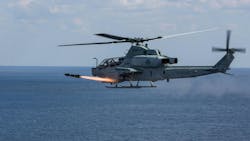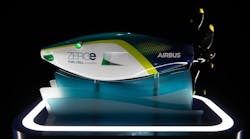PATUXENT RIVER NAS, Md. – Military helicopter designers at Bell Helicopter in Fort Worth, Texas, will build 12 new AH-1Z Viper attack helicopters and avionics for the government of Nigeria under terms of a near-half-billion-dollar order announced last week.
Officials of the U.S. Naval Air Systems Command at Patuxent River Naval Air Station., Md., announced a $455 million order to Bell Helicopter, a Textron Inc. company, to manufacture and deliver 12 AH-1Z helicopters. The order includes engineering, program management and logistics support, and non-recurring engineering for obsolescence.
The AH-1Z is a twin-engine attack helicopter based on the Bell AH-1W SuperCobra that features a four-blade rotor system, uprated transmission, and a new target-sighting system. It has upgraded avionics, weapons, and electro-optical sensors designed to find targets at long ranges and attack them with precision weapons.
This order coincides with a $7.7 million contract to the Northrop Grumman Corp. Mission Systems segment in Woodland Hills, Calif., for 32 H-1 technology-refresh mission computers for the Nigerian AH-1Z helicopters.
The AH-1Z helicopter can carry a payload of 5,764 pounds, can fly as fast as 222 knots, has a range of 370 nautical miles, and can fly as high as 20,000 feet above sea level. The AH-1Z has a crew of two, carries a 20-millimeter Gatling gun, and can fire 70-millimeter Hydra rockets, AIM-9 Sidewinder air-to-air missiles, and AGM-114 Hellfire air-to-ground missiles.
The attack helicopter avionics has integrated night vision goggle (NVG)-compatible glass cockpit, advanced electronic warfare self protection (EWSP suite, and ballistically hardened components to protect the helicopters from a broad range of enemy weapons.
It has high-resolution forward-looking infrared resolution that provides long-range detection, identification, and engagement capabilities.
Northrop Grumman has developed the integrated avionics systems for the AH-1Z. The systems include two mission computers and an automatic flight control system with four-axis stability control augmentation system. Each crew station has two 8-by-6-inch multifunction displays and one 4.2-by-4.2-inch dual-function display, based on active-matrix liquid-crystal color technology.
The displays come from the L-3 Technologies Ruggedized Command and Control Solutions segment in San Diego. GE Aviation Systems in Grand Rapids, Mich., provides the weapon stores control and data transfer system.
Thales Avionics in Arlington, Va., provides the AH-1Z TopOwl helmet-mounted display system. It has integrated image intensifier and forward-looking infrared (FLIR) capability and provides transition from day to night use at the push of a button.
The Northrop Grumman Gen III FlightPro mission computers are the heart of the AH-1Z's integrated avionics system (IAS) that powers the helicopter's glass cockpit avionics.
The Gen III mission computer incorporates a ruggedized 6U VME PowerPC-based single board computer. Interfaces include Fast Ethernet, four serial ports, parallel I/O, and built-in-test. FlightPro has a standard partitioned real-time operating system called INTEGRITY-178 tuMP for multicore architectures from Green Hills Software in Santa Barbara, Calif., with ARINC 653 and POSIX support.
The mission computer's standard configuration also includes a quad channel 1553 mezzanine card, high-speed serial card, digital I/O module with eight channels of opto-coupled discrete inputs, eight channels of opto-coupled discrete outputs, and 16 channels of general-purpose bi-directional discretes that can be programmed individually as outputs or inputs.
The FlightPro mission computer is capable of Required Navigation Performance/Area Navigation (RNP/RNAV) in all flight regimes, including departure, en route, terminal, and non-precision approach using GPS as the sole navigation source.
The flight computers use 28-volt DC or 115-volt AC three-phase 400 Hz input power, measure 13.61 by 11.5 by 7.55 inches, and weigh 30.4 pounds. The computers have rated 3,200 hours mean time between failures.
The flight computer software is RTCA DO-178C compliant, has ARINC-653 partitioning for safety and security, and complies with the Modular Open Systems Architecture (MOSA) standard. The software is aligned with the Future Airborne Capability Environment (FACE) technical standard, has hardware-independent application software developed to MIL-STD-498, under MIL-STD-882C safety program environmental qualification.
Related: Northrop to build avionics mission computers for AH-1Z Viper helicopter
Flight computer hardware is designed to MIL-STD-461D for electro-magnetic compatibility, and is tested to MIL-STD-462 and MIL-STD 810E. FlightPro is conduction cooled, and represents “Quiet Cockpit Technology,” Northrop Grumman officials say.
Dual mission computers are the heart of Northrop Grumman's Integrated Avionics System (IAS) that powers the glass cockpits of the AH-1Z helicopter. The mission computers provide centralized control of the IAS and display situational awareness and health monitoring information.
Additionally, the IAS and mission computers can accommodate future system upgrades; rapid insertion of new technologies; and integration of other avionics, communications, and survivability equipment. Northrop Grumman also provides the operational flight program software that controls the IAS.
On this order Bell will do the work in Fort Worth and Amarillo, Texas, and should be finished by July 2028. For more information contact Bell Helicopter online at www.bellflight.com/products/bell-ah-1z, Naval Air Systems Command at www.navair.navy.mil, or the Nigerian Ministry of Defence at https://defence.gov.ng.



